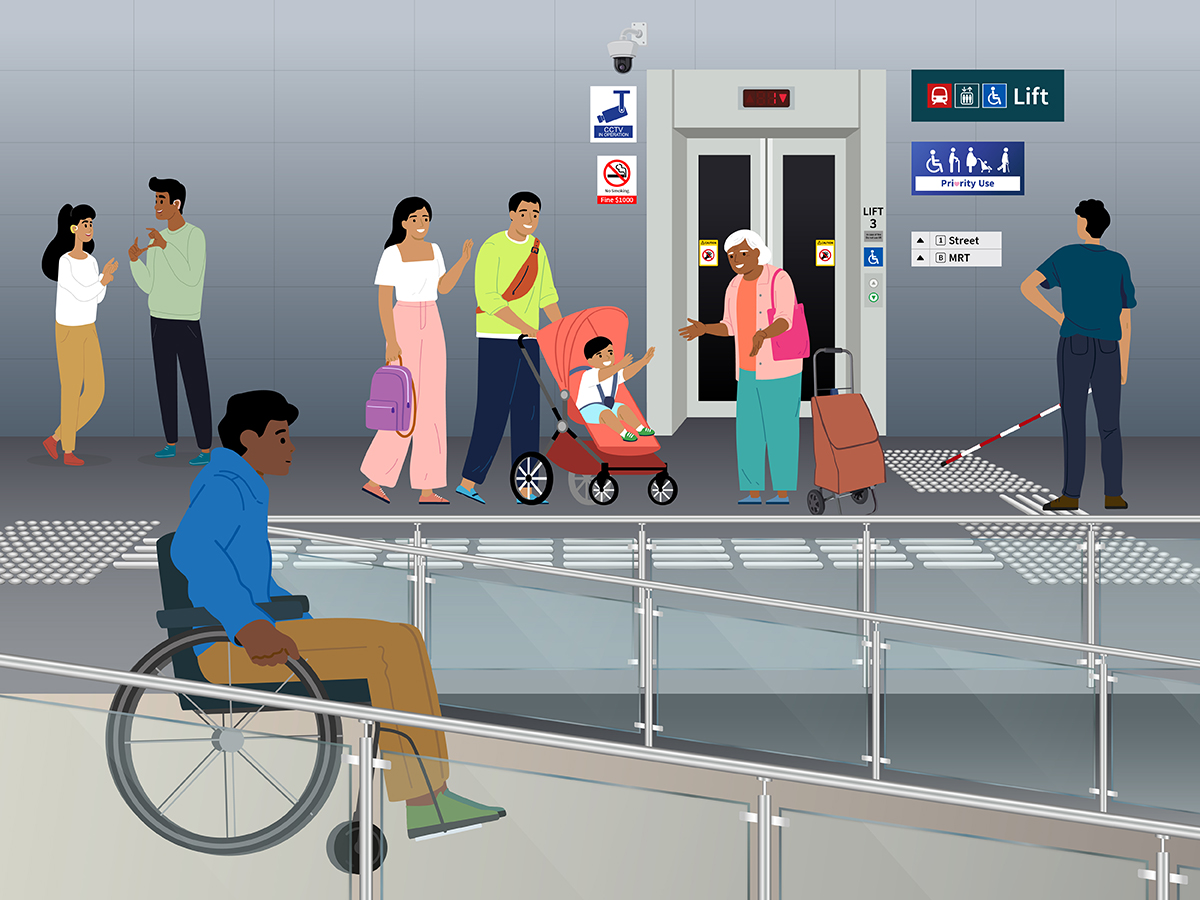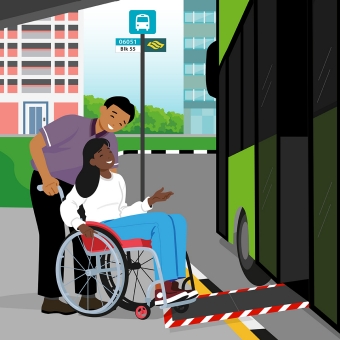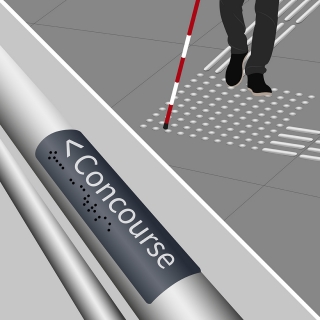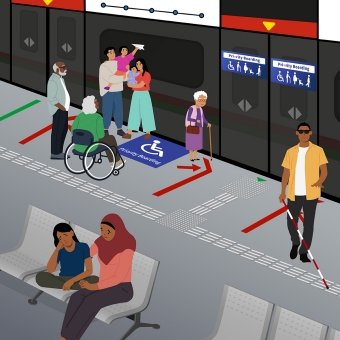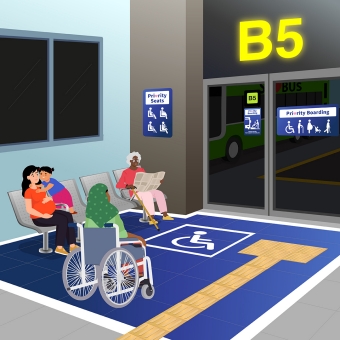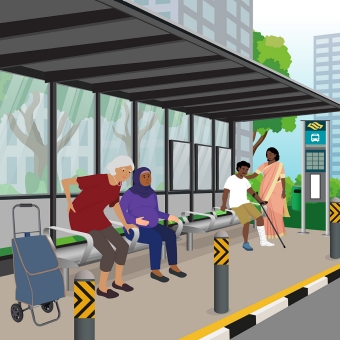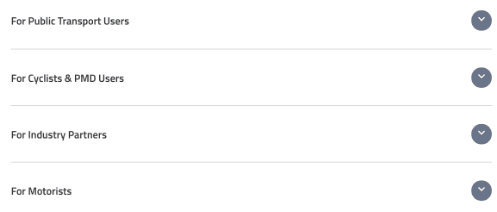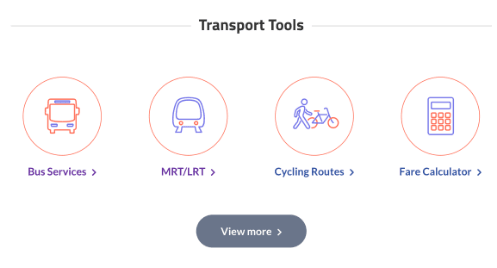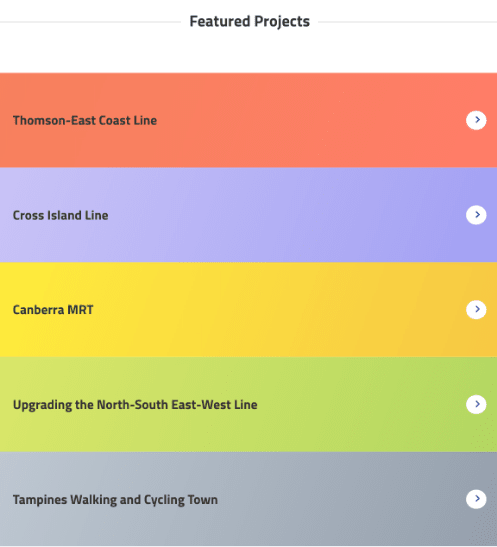An Inclusive Public Transport System
Making it Easier to Get Around
Public transport is always a good option, whether you are making your way in a personal mobility aid (PMA) like a wheelchair or mobility scooter, or taking junior out in a stroller. Know you’re in good hands — the MRT, LRT and public buses are designed to accommodate these needs, ensuring comfortable journeys for everyone.
For people with mobility challenges, PMAs are a boon, helping them to move around even on public transport. Users of other active mobility devices such as bicycles, power-assisted bicycles, motorised and non-motorised personal mobility devices (PMDs) can bring these on public transport, but they must be switched off. The devices must also meet the stipulated dimensions (120cm in length, 70cm in width and 40cm in height) when folded.
Tips When Using Open Strollers and PMAs on Public Transport

Size and Weight
Strollers and PMAs within the following dimensions can be safely brought on board public transport:
Total weight (PMA including user): 300kg
Length: 120cm
Width: 70cmHeight (from floor to top of PMA or user’s head when seated, whichever is higher): 150cm
On Board
Use the designated spaces on our buses and trains for PMAs and strollers. The handrails are conveniently positioned to keep users safe, while also making the ride more comfortable for all passengers. When parked in these slots, the aisles, stairways, entries and exits will be clear for easy movement.
For safety, secure your stroller using the restraints provided on buses and engage the brakes on the stroller.
PMAs are best positioned facing the rear of the bus, and should have their brakes engaged. Do hold on to the handrails for better security.
Safe Boarding and Alighting
Buses
98% of our bus stops are barrier-free accessible (BFA). Only a few, such as those located at five-foot ways, are not. Check by looking for the wheelchair logo on the bus stop pole, or check the MyTransport mobile app (iOS | Android).
Take your child’s stroller through the front door, unless it is too large. Don’t worry about being a hassle, as our bus captains can help if you need help boarding, or with your fare payment if you use the rear door. If the bus is crowded, please comply if the captain requests that you fold your stroller.
A ramp is available at the rear door for commuters using PMAs. Please wait for the bus captain to deploy it and assist you.
Trains
Good news: all our MRT and LRT stations in Singapore are barrier-free!
Wherever possible, rubber fillers are installed to plug the gap between the platforms and the trains. Our station staff and service ambassadors are also ready to lend a hand — just approach our Passenger Service Centres.
More Barrier-Free Access at Taxi Facilities
LTA is in the process of reviewing our existing taxi stands to make them barrier-free where possible.
Wayfinding with Braille and Tactile Aids
Hearing Enhancement System
Commuters who wear hearing aids now have an easier time communicating with our Passenger Service Centre staff. A Hearing Enhancement System (HES) is employed at all Thomson-East Coast Line MRT stations and will be included in all future stations and existing bus interchanges (those that are undergoing upgrading works).
Looking Out for Commuters
Helping Hand Scheme

Notice someone wearing one of these yellow signs from LTA? A gracious response would be most welcome, especially when it’s difficult for the wearer to ask for assistance.
1. “May I have a seat please”
Not all health conditions or disabilities are visible. Commuters with short-term conditions (such as those on medical leave) can ask for this sticker before their trip.

2. “This is a wheelchair”
Paediatric wheelchairs are easily mistaken for strollers. This sign tells public transport staff and other commuters that the wheelchair cannot be folded. Bus captains may also help by activating the ramp for boarding and alighting.
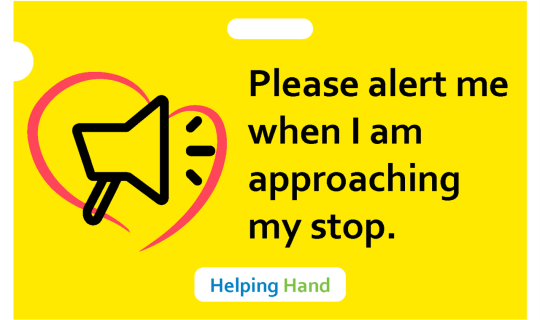
3. “Please alert me when I am approaching my stop”
When low vision, dementia or other conditions make it difficult for a commuter to know where to alight, bus captains will let them know to get ready when the bus is nearing their destination.
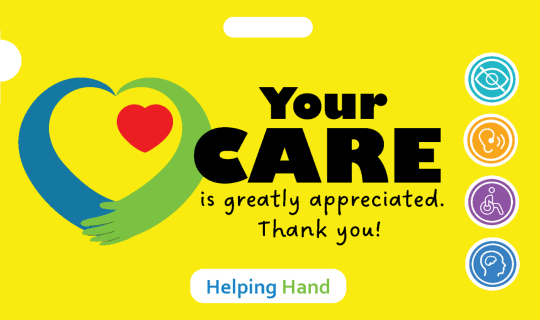
4. Universal Helping Hand card
For commuters whose needs are not met with the three Helping Hand cards mentioned above, they may instead use the new universal Helping Hand card. It allows commuters to specify the help that they require at the back of the card.

The Helping Hand scheme follows positive feedback from LTA’s pilot of the “May I have a seat please” sticker, as well as Go-Ahead Singapore’s subsequent trial. The lanyard designs were adapted from artwork by commuters with disabilities or special needs through an art competition jointly organised by LTA and a youth group, the Movement of Inclusivity.
These Helping Hand identifiers can be obtained from:
- Passenger Service Centres at MRT stations and bus interchanges.
- SimplyGo Ticket Offices at Ang Mo Kio, Chinatown, Clementi, Tampines, Woodlands and Yishun MRT stations, and Ang Mo Kio, Bedok and Jurong East bus interchanges.
Used one and received some courtesy? Do show your appreciation and spread the cheer.
Dementia Go-To Points (GTPs)

Put your mind at ease when Grandpa or Grandma are out and about, even if they are living with dementia. All public transport nodes serve as “safe-return” Go-To Points for people with dementia, where members of the public can lead them to if they seem lost. Our staff are trained to help reunite them with their families or caregivers.
Information about dementia-related services is also provided at the GTPs. Other Dementia GTPs can be found around the island, too.
Caring Commuter Champions
Sign Up as A Caring Commuter Champion

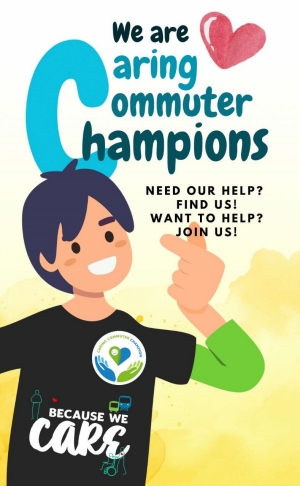
You can recognise volunteers by the t-shirts they wear.
You can make a difference as a Caring Commuter Champion, too.
Sign up to receive online training on how to help vulnerable commuters appropriately, and be part of the Caring SG Commuters movement.
Giving Way to Those in Need
Priority Queues for Boarding
Know what to do when you’re stuck in a queue — give way to the elderly, expectant mothers, families with strollers and commuters with disabilities! These more vulnerable groups can also make use of the Priority Queue zones next to the usual queues at bus interchanges and MRT/LRT stations, where seats are also available for a comfortable wait.
Unfortunately, if the bus is here and the designated wheelchair space on board is already occupied or the bus is very crowded, PMA users may need to wait for the next bus, while strollers will have to be folded and carried.
Priority Seats
All bus seats between the entrance and exit doors are designated as Priority Seats, as well as the first row after the exit door.
Making Your Commute More Enjoyable
More Ergonomic Elder-Friendly Seats
A day out on the public transport system is convenient and comfortable. Leave the stress behind, as every effort is made to make your journey more pleasant.
Senior-Friendly Seats
Seats at bus stops, taxi stands, bus interchanges and MRT stations are designed with armrests to aid sitting and getting up. At new MRT stations, seating is conveniently located at points where seniors might need to rest. These seats have backrests and are also in high-contrast colours for more visibility, to prevent accidental falls.
Family-Friendly Facilities
Our latest bus interchanges and MRT stations have baby care rooms, diaper changing stations and child-height toilets and wash basins.
More Ways to Receive Public Annoucements
Announcements on a busy train can sometimes be hard to hear, but overhead electronic signboards in the carriages make it easy to read them as well.




